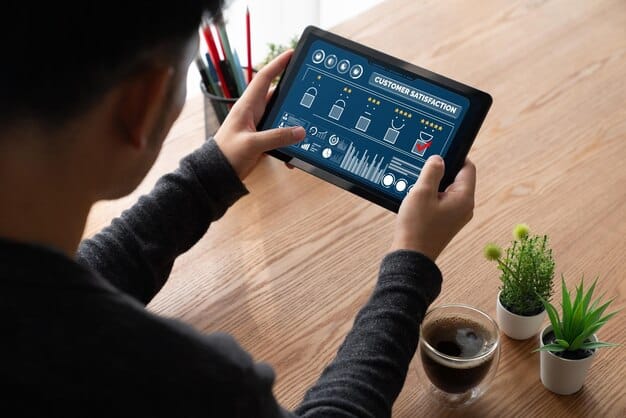Mobile Device Security: Protecting Your Company’s Data

Mobile device security is crucial for protecting company data on employee-owned devices by implementing strategies like password enforcement, encryption, mobile device management (MDM) solutions, and regular security updates to mitigate risks such as data breaches and malware infections.
In today’s interconnected world, mobile devices have become essential tools for business operations. However, the increasing use of employee-owned devices, or Bring Your Own Device (BYOD), introduces significant security risks. Ensuring robust mobile device security: protecting your company’s data on employee-owned devices, is now more critical than ever.
Understanding the Risks of Using Employee-Owned Devices
The convenience of employee-owned devices in the workplace comes with a set of inherent security challenges. These risks can range from data breaches and malware infections to unauthorized access and data leakage.
Data Breaches and Unauthorized Access
One of the primary risks associated with BYOD is the potential for data breaches. When employees use their personal devices for work, sensitive company information can be compromised if the device is lost, stolen, or infected with malware. Unauthorized access can also occur if the device lacks proper security measures.
Malware Infections and Phishing Attacks
Personal devices are often more susceptible to malware infections and phishing attacks compared to company-managed devices. Employees may not have the same level of security awareness or may be less diligent in updating their devices and software.

- Ensure employees understand how to identify and avoid phishing attempts.
- Regularly update mobile devices with the latest security patches.
- Implement mobile threat defense solutions to detect and prevent malware infections.
Addressing these risks is crucial for maintaining the integrity and confidentiality of company data.
Implementing a Mobile Device Security Policy
A comprehensive mobile device security policy is the foundation for protecting company data on employee-owned devices. This policy should outline clear guidelines and expectations for employees regarding device usage, security measures, and compliance requirements.
Key Components of a Security Policy
A well-defined mobile device security policy should include several key components. These components provide a framework for managing and securing employee-owned devices within the company’s IT environment.
Password Enforcement and Authentication: Require employees to use strong, unique passwords and implement multi-factor authentication (MFA) for accessing company resources.
Data Encryption and Secure Storage
Data encryption is essential for protecting sensitive information stored on mobile devices. Encryption ensures that data remains unreadable even if the device is lost or stolen.
- Implement full-disk encryption on all employee-owned devices used for work.
- Use secure storage solutions for sensitive data, such as encrypted containers or cloud storage with robust security measures.
- Regularly back up data to prevent data loss in case of device failure or theft.
Having a strong policy in place is critical for minimizing the risks associated with BYOD.

Mobile Device Management (MDM) Solutions
Mobile Device Management (MDM) solutions offer a centralized approach to managing and securing mobile devices within an organization. MDM software provides features such as remote device configuration, application management, and security policy enforcement.
Benefits of Using MDM
Implementing an MDM solution can significantly enhance mobile device security and streamline IT administration. Some of the key benefits include:
Remote Device Management: MDM allows IT administrators to remotely configure, monitor, and manage mobile devices.
Application Management: MDM enables organizations to control which applications can be installed on employee-owned devices.
- Ensure the MDM solution supports the operating systems and device types used by employees.
- Regularly update the MDM software to benefit from the latest security features and patches.
- Provide training and support to employees on how to use the MDM solution effectively.
MDM solutions are a powerful tool for businesses looking to enhance their mobile device security posture.
Best Practices for Securing Employee-Owned Devices
In addition to implementing a mobile device security policy and using MDM solutions, there are several best practices that can help enhance the security of employee-owned devices.
Regular Security Updates and Patch Management
Keeping mobile devices up-to-date with the latest security updates and patches is critical for protecting against known vulnerabilities. Software updates often include fixes for security flaws that can be exploited by attackers.
Secure Wi-Fi Usage and VPNs
Using secure Wi-Fi networks and Virtual Private Networks (VPNs) can help protect data transmitted over the internet. Public Wi-Fi networks are often unsecured and can be easily intercepted by attackers.
- Educate employees about the risks of using unsecured Wi-Fi networks.
- Require employees to use a VPN when accessing company resources over public Wi-Fi.
- Implement security measures to prevent unauthorized access to the company’s Wi-Fi network.
By following these best practices, organizations can significantly reduce the risk of security incidents.
Employee Training and Awareness
Employee training and awareness are essential components of a strong mobile device security strategy. Employees need to be educated about the risks associated with using mobile devices and the importance of following security policies and best practices.
Developing a Security Awareness Program
A security awareness program should cover a range of topics, including:
Phishing Awareness: Teach employees how to recognize and avoid phishing emails, text messages, and phone calls. Phishing attacks are a common way for attackers to steal credentials and gain access to company data.
Password Security: Emphasize the importance of using strong, unique passwords and not sharing them with others. Encourage employees to use password managers to generate and store strong passwords.
- Provide regular security awareness training sessions to keep employees informed about the latest threats and best practices.
- Use real-world examples and case studies to illustrate the potential impact of security incidents.
- Test employees’ knowledge through quizzes and simulations to reinforce learning.
A well-informed workforce is a critical asset in the fight against cyber threats.
Monitoring and Incident Response
Implementing monitoring and incident response procedures is crucial for detecting and responding to security incidents involving employee-owned devices. Monitoring involves tracking device activity and network traffic to identify suspicious behavior.
Establishing Incident Response Procedures
Incident response procedures should outline the steps to be taken in the event of a security incident. These procedures should include:
Reporting Procedures: Establish clear procedures for employees to report suspected security incidents, such as lost or stolen devices, phishing attempts, or malware infections.
Containment Measures: Implement measures to contain the impact of a security incident, such as remotely wiping a compromised device or isolating it from the network.
- Develop a detailed incident response plan that outlines roles, responsibilities, and communication protocols.
- Regularly test the incident response plan through simulations and drills.
- Use security information and event management (SIEM) systems to centralize and analyze security logs.
Having a robust monitoring and incident response capability is essential for minimizing the damage caused by security incidents.
| Key Point | Brief Description |
|---|---|
| 🛡️ Security Policy | Establish clear guidelines for device usage and data protection. |
| 📲 MDM Solutions | Use MDM to manage, monitor, and secure mobile devices centrally. |
| 🧑🏫 Employee Training | Educate employees on security best practices and risks. |
| 🚨 Incident Response | Implement procedures for detecting and responding to security incidents. |
Frequently Asked Questions (FAQ)
Mobile device security refers to the measures taken to protect sensitive information stored on or accessed through mobile devices, such as smartphones and tablets, from unauthorized access, data breaches, and malware infections.
Mobile device security is crucial for businesses because these devices often store or access confidential company data. A security breach can lead to financial losses, reputational damage, and legal liabilities. Protecting these devices is essential for maintaining business operations.
Common threats include malware infections, phishing attacks, unsecured Wi-Fi networks, lost or stolen devices, and weak passwords. These threats can compromise device security and allow unauthorized access to sensitive data.
You can improve mobile device security by implementing a comprehensive security policy, using MDM solutions, providing employee training, enforcing strong password policies, and regularly updating devices with the latest security patches.
MDM stands for Mobile Device Management. It is software that allows IT administrators to remotely manage, monitor, and secure mobile devices. It helps by enforcing security policies, managing applications, and remotely wiping compromised devices.
Conclusion
Protecting company data on employee-owned devices requires a multifaceted approach that includes implementing a comprehensive security policy, utilizing Mobile Device Management (MDM) solutions, educating employees about security risks, and establishing robust monitoring and incident response procedures. By taking these steps, organizations can significantly reduce the risks associated with BYOD and ensure the confidentiality, integrity, and availability of their data.





